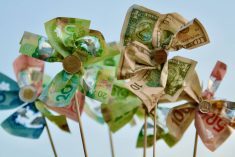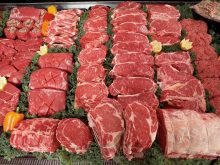During mid-February, Alberta packers were buying fed cattle on a live basis in the range of $150 to $150.50 FOB the feedlot; delivered prices on a dressed basis were quoted in the range of $254 to $255.
The fed cattle market has been percolating higher over the past month. Beef production has exceeded earlier expectations but overall demand has also come in stronger than anticipated. People are eating more beef at higher prices. This is the only recession in history where we’ve seen an increase in disposable income. At the same time, there has been a change in culture with families eating at home. At-home food spending appears to more than offset the drop in restaurant spending.
Read Also

Harvest wraps up and fall work begins
At the Eppich famly ranch in western Saskatchewan, the fall harvest was successful with few breakdowns, cows and calves have been sorted and a new tractor has arrived
Feedlot margins have improved and are close to moving into positive territory. This has spilled over into the feeder complex and we’ve seen yearlings and light calves jump $4 to $8 from early January. On the Jan. 1 semi-annual cattle inventory report, the USDA made a downward revision to the 2019 calf crop and the 2020 calf crop came in lower than expected. In central Alberta, larger-frame medium-flesh tan steers weighing 825 pounds were quoted at $184; Angus-based steers on a full health program averaging 610 pounds were valued at $220.
The western Canadian fed cattle market continues to deal with the after-effects of the COVID pandemic. However, packers are slowly cleaning up the backlog of market-ready supplies.
Given the current processing and export pace, it now looks like fed cattle supply and demand should be in balance by the end of April. During the latter part of 2020, western Canadian imports of U.S. feeder cattle were down sharply from year-ago levels. Lower imports of feeder cattle combined with the year-over-year decline in feedlot placements should result in a year-over-year decline of market ready cattle during the summer months.
U.S. first-quarter beef production is coming in larger than anticipated. I’ve included the accompanying quarterly beef production estimates from the January and February World Agriculture Supply and Demand Estimates (WASDE). Notice the USDA increased first-quarter production by 150 million pounds on the February report while second-quarter output was raised by100 million pounds.
Quarterly production is also above 2019 which is truer comparison to market fundamentals. Cattle-on-feed inventories in the U.S. are running slightly above year-ago levels. U.S. steer and heifer carcass weights continue to exceed year-ago levels by 20 to 23 pounds, resulting in higher production.
Beef demand is inelastic — a small change in supply has a large influence on price. Secondly, consumer spending and beef demand are highly correlated. As of mid-February, the February live cattle futures were around $117; if production reached over 7.0 billion pounds, the futures would be under $110. Wholesale beef prices have experienced a counter-seasonal trend during the winter period. The stimulus packages appear to have alleviated the concerns over high unemployment. Consumer incomes have surged and with the business and restaurant constraints, people are eating more beef at home. The main concern is that beef demand will decrease once people resume their normal lifestyles later in summer the effects of the direct stimulus cheques eases.
The USDA estimated the 2020 calf crop at 35.1 million on the Jan. 1, 2021 semi-annual inventory report. This is down from the July estimate of 35.8 million head. The USDA also made a downward revision to the 2019 calf crop. It appears that 2019 calf crop was closer to 35.6 million head, down from the previous estimate of 36.1 million head. As of mid-February, the November feeder cattle futures were $9 premium to the May contract. The feeder cattle market is moving through a fundamental change, which should result in higher prices. I’m expecting grass cattle to trade at fresh 52-week highs this spring. Next fall, central Alberta yearling steers averaging 850 pounds are expected to reach the psychological $200 level which is up $10 to $15 from September of 2020. Statistics Canada is also expected to show a year-over-year decline in the calf crop on the upcoming Canadian report.
The fed and feeder cattle price outlooks for 2021 are quite positive. The U.S. cattle herd is contracting and the North American economies are moving into a full-fledged expansionary phase. Looking at past history, this environment is usually the most profitable period for cattle producers. At the same, we have an artificial demand situation in the short term. The government stimulus and aid packages have inflated consumer incomes. The longer-term outlook is positive. The short-term market environment will be very volatile. Look for enhanced volatility over the next few months because the market will be very sensitive to minor changes in supply and demand.
















